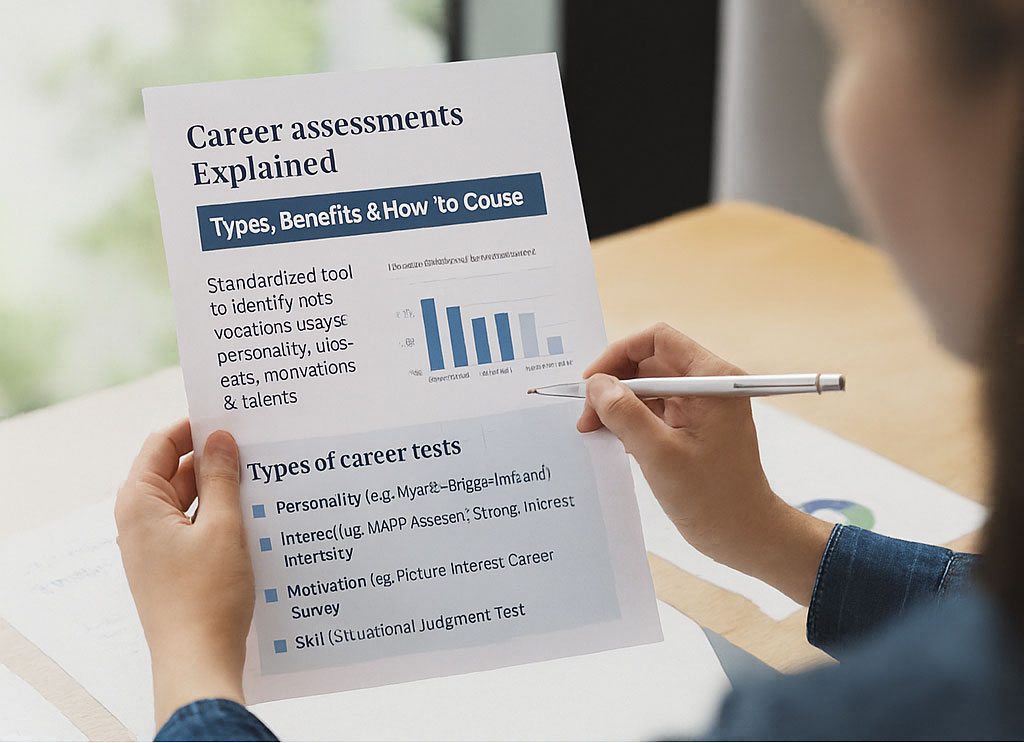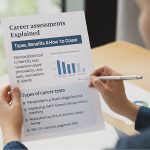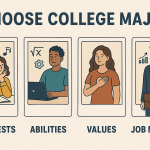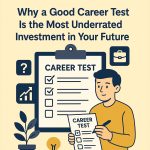Career News
AI Job Displacement: 5-Year Outlook & Career Strategies

AI, Automation, and the Five-Year Jitters: Why U.S. Workers Are Anxious—and How to Respond Proactively
By Careertest.com staff writer & Career Coach
- A New Wave of Workplace Anxiety
Walk into almost any break room and you’ll hear versions of the same question: “Will a machine take my job?” That anxiety is more than water-cooler gossip. A February 2025 Pew Research Center survey found that 52 % of American workers are worried about AI’s future impact on their own workplaces, while only 28 % feel mostly hopeful. Pew Research Center High-profile CEOs are fanning those flames. At the Aspen Ideas Festival, Ford’s Jim Farley warned that AI could displace “literally half of all white-collar workers.”News.com.au
Other data confirm the unease. A Resume-Now “AI Disruption” poll of 2,000 U.S. employees reported that 9 in 10 workers fear some degree of displacement over the next five years. Among CFOs surveyed by Grant Thornton, 28 % believe AI will diminish or replace their own roles. CFO Dive Are you freaking out yet? Some are freaking out, others don’t think its real. While there have been many automation cycles in our country, many think this one may be different.
- Why This Automation Cycle Feels Different
Four forces converge to make this moment uniquely unsettling:
- Scope Creep from Blue Collar to White Collar. Traditional robotics threatened manufacturing; generative AI now drafts legal briefs, writes code, and produces marketing copy, encroaching on cognitive work once deemed “safe.” Brookings estimates that more than 30 % of workers could see half of their tasks disrupted by generative AI. Brookings
- Speed of Diffusion. McKinsey’s 2024 survey shows 71 % of organizations already pilot or deploy generative AI in at least one function a pace far faster than past tech waves. Brookings
- Visibility of Capabilities. ChatGPT-style tools let employees witness AI writing reports in seconds, making displacement feel visceral.
- Media Amplification. Headlines promising both “productivity miracles” and “20 % unemployment” arrive daily, triggering cognitive dissonance.
- Psychological Fallout: Identity, Control, and Uncertainty
From a clinical-psychology lens, job-loss anxiety taps three core threats:
| Threat Trigger | Psychological Impact | Typical Worker Reaction |
| Identity Loss (“What will I be if my role vanishes?”) | Grief, lowered self-esteem | Over-identification with current title, resistance to change |
| Loss of Control (tech decisions made “above my pay grade”) | Learned helplessness, rumination | Rumor-sharing, withdrawal from upskilling |
| Uncertainty (no clear timeline) | Intolerance of ambiguity, chronic stress | Doom-scrolling, career paralysis |
Unchecked, these responses erode wellbeing and performance. Employers that ignore them risk disengagement long before actual layoffs occur.
- Sectors and Roles Most Exposed by 2030
Synthesizing Brookings, Pew, and McKinsey analysis reveals three exposure tiers for the 2025-2030 horizon:
| Exposure Tier | Job Clusters | Dominant Vulnerability |
| High | Data entry clerks, telemarketers, basic bookkeeping, paralegals, insurance underwriters | Rule-based information processing easily modeled by LLMs |
| Medium | Mid-level software developers, graphic designers, financial analysts | Partial automation of code, design, or forecasting; human oversight still critical |
| Lower (but not zero) | Skilled trades, healthcare practitioners, mental-health professionals, K-12 educators, complex sales | High interpersonal interaction, manual dexterity, or contextual judgement |
Not “zero” because workflow tools (e.g., AI scribing in clinics) will still reshape task mixes.
- The Near-Term Timeline (Next Five Years)
- 2025-2026: Rapid copilots roll-out AI drafts first-pass outputs, humans revise. Job counts remain flat but task composition shifts.
- 2027-2028: Cost-benefit triggers restructuring in finance, legal ops, and customer support. Expect selective head-count reductions of 10-25 % in clerical firms.
- 2029-2030: Early adopters refine AI governance; laggard firms accelerate catch-up. The net employment impact hinges on reskilling success.
- Proactive Strategies for Individual Workers
Goal: Shift from “Will AI replace me?” to “How can I stay indispensable—and even ride the wave?”
| Strategic Pillar | Purpose | Concrete Payoff |
| 6.1 Skill Audit & Foresight | Know exactly which of your tasks are automatable, complementary, or uniquely human. | A clear, evidence-based map of risk vs. opportunity. |
| 6.2 Complementary Skill Building | Develop abilities that partner with AI (e.g., data storytelling, prompt-engineering). | Keeps you on the augmentation side of the ledger. |
| 6.3 Multi-Path Career Mapping | Identify 3 adjacent roles—with different AI exposure levels—before you need them. | Optionality; leverage existing strengths for smoother pivots. |
| 6.4 Psychological Resilience & Networking | Manage anxiety, maintain motivation, and build diverse professional safety nets. | Higher adaptability and faster access to hidden opportunities. |
Below you’ll find the full playbook for 6.1 the essential first step that powers everything else.
6.1 Skill Audit & Foresight
“Automation threatens tasks, not whole humans. Separate the two and you reclaim control.” Author
Step 1 – List Your Work Components
- Spend one week documenting tasks in real time.
- Tag each with time spent (%) and required knowledge/skill.
- Example output (Marketing Analyst):
- Pull weekly ad-spend data (10 %)
- Build performance dashboards (20 %)
- Present insights to stakeholders (15 %)
- Brainstorm campaign angles (20 %)
- Vendor negotiations (15 %)
- Internal training & mentoring (20 %)
Step 2 – Run the “Automation Likelihood Grid”
| Automation Likelihood | Task Characteristics | Typical AI Tool | Your Example Task |
| High | Rule-based, repeatable, data-heavy | Robotic process automation, GPT dashboards | Ad-spend data pulls |
| Medium | Semi-structured, requires judgment | Copilot code, AI analytics | Dashboard building |
| Low | Ambiguous, creative, interpersonal | Limited augmentation | Brainstorming, negotiations, mentoring |
Step 3 – Quantify Exposure
- Risk Score = (High % × 1.0) + (Medium % × 0.5).
- In the example: (10 % × 1) + (20 % × 0.5) = 20 % exposure.
- Anything ≥ 40 % suggests an urgent upskilling plan.
Step 4 – Identify Complementary & Transferable Skills
For each High-risk task, ask:
- What “human layer” amplifies this activity? (e.g., framing insights for executives)
- Which adjacent roles value that layer? (e.g., Product Marketing Manager)
Map your answers into three columns Automatable, Augmentable, Uniquely Human—and look for clusters that point to future-proof roles.
Step 5 – Leverage External Foresight Tools
- O*NET Task Crosswalk: Check emerging skills for your SOC code.
- WEF Future of Jobs Report: Validate macro demand trends.
- Assessment.com’s MAPP Career Assessment:
- Generates a motivation/aptitude profile.
- Cross-references 1,000+ occupations to show where your human strengths already align.
- Provides a numerical compatibility score for each role perfect for prioritizing low-exposure pathways.
Output of a Completed Audit
- One-page dashboard showing:
- Personal AI-exposure percentage.
- Top 5 augmentable skills to double-down on.
- Three low-exposure career paths ranked by MAPP compatibility.
Why It Works
- Turns abstract fear into concrete data.
- Creates a north star for subsequent training or career pivots.
- Gives you language to negotiate with managers (“Here’s how I can add AI-augmented value”).
Key takeaway: A rigorous Skill Audit & Foresight exercise transforms uncertainty into a strategic roadmap setting the stage for upskilling, job crafting, or career transition before disruption hits.
Start with a rigorous self-inventory: Which of your daily tasks are transferable, which are uniquely human, and which are automatable? Tools such as O*NET’s task database and the World Economic Forum’s “Skills of 2025” list are useful benchmarks.
6.2 Expand the “Complementary” Skill Set
McKinsey identifies creativity, complex problem-solving, interpersonal influence, and AI-augmented analysis as growth areas. Translate that into micro-commitments:
- Creativity: Ship one mini-project monthly (podcast episode, design mock-up, or prototype) using AI as ideation partner.
- Data Literacy: Complete a basic prompt-engineering or no-code analytics course; treat AI as colleague, not competitor.
6.3 Build Optionality Through Career Mapping
Rather than betting on a single pivot, map three adjacent roles one inside your company, one in a related industry, and one moon-shot aspiration. Each should score high on task diversity and human-centric interaction.
6.4 Psychological Resilience
Practice evidence-based stress reduction: cognitive reframing, mindfulness, and social support. Research shows workers with higher career adaptability curiosity, confidence, concern, control report less AI anxiety. Forbes
- Less-Disrupted Career Paths (2025-2030 Outlook)
Below are examples of roles projected to maintain or grow demand despite automation:
| Domain | Why It’s Resilient | Example Roles |
| Healthcare & Mental Health | Empathy, nuanced diagnostics, and physical procedures resist full automation. | Nurse practitioners, occupational therapists, mental-health counselors |
| Skilled Trades & Infrastructure | Hands-on dexterity, on-site problem solving, and backlog of U.S. infrastructure projects. | Electricians, HVAC techs, renewable-energy installers |
| AI Oversight & Ethics | Need for explainability, bias audits, and governance frameworks. | AI compliance officer, model auditor |
| Education & Workforce Development | Personalized guidance and adaptive content design. | Instructional designers, corporate learning architects |
| Human-Centered Sales & Partnerships | Complex negotiation and relationship management. | Enterprise account executives, channel-partnership managers |
| Creative Strategy & Brand Storytelling | Human originality and cultural nuance. | Creative directors, UX researchers |
- From Anxiety to Agency: Leveraging the MAPP Career Assessment
Facing possibility spaces can feel overwhelming. One antidote is structured self-assessment. The MAPP Career Assessment on Assessment.com has helped over 9 million users map motivations, aptitude patterns, and culture fit. Unlike generic “interest” quizzes, MAPP’s psychometric engine provides:
- Core Motivation Profile – pinpoints intrinsic drivers (achievement, problem-solving, altruism).
- Job Fit Scores – ranks 1,000+ occupations against your unique profile.
- Transferability Lens – shows adjacent roles where your strengths already apply, essential for low-friction pivots.
Take action: Investing 15 minutes in the free MAPP assessment can surface alternative paths less susceptible to AI displacement and spotlight upskilling priorities you hadn’t considered.
- What Employers & Policymakers Must Do
- Transparent Workforce Planning. Share automation roadmaps quarterly; uncertainty shrinks when timelines are explicit.
- Skills-Based Hiring & Internal Mobility. Replace credential gatekeeping with demonstrable-skill assessments (coding challenges, simulation-based tasks).
- Lifelong-Learning Credits. Brookings warns that traditional retraining fails without funding and time allowances; companies should earmark 0.5-1 % of payroll for individual learning wallets. Brookings
- Mental-Health Integration. Offer resilience workshops and access to therapists who understand tech-driven career shock.
- A Five-Year Roadmap for the Individual
| Year | Key Milestone | Action Item |
| 2025 | Self-Awareness | Complete MAPP assessment; map skill gaps vs. resilient roles. |
| 2026 | Skill Stack Refresh | Enroll in one credential (e.g., AI ethics, human-centered design). |
| 2027 | Portfolio Build | Ship a publicly visible project or case study each quarter. |
| 2028 | Network Diversification | Join two professional communities outside your current role. |
| 2029 | Mobility Moment | Target lateral move or promotion into a role with higher AI complementarity. |
- Conclusion: Fear as a Catalyst, Not a Crutch
The next half-decade will bring real disruption, pretending otherwise fuels helplessness. Yet history shows that technology reallocates work at least as often as it eliminates it. Workers who (1) understand their transferable strengths, (2) cultivate complementary skills, and (3) proactively map multiple options will not just survive but thrive.
Start by transforming generalized worry into data-driven insight and the fastest route is a rigorous career assessment. Take the free MAPP Career Assessment on Assessment.com today; in less time than a coffee break, you’ll gain a GPS for navigating the AI era.





